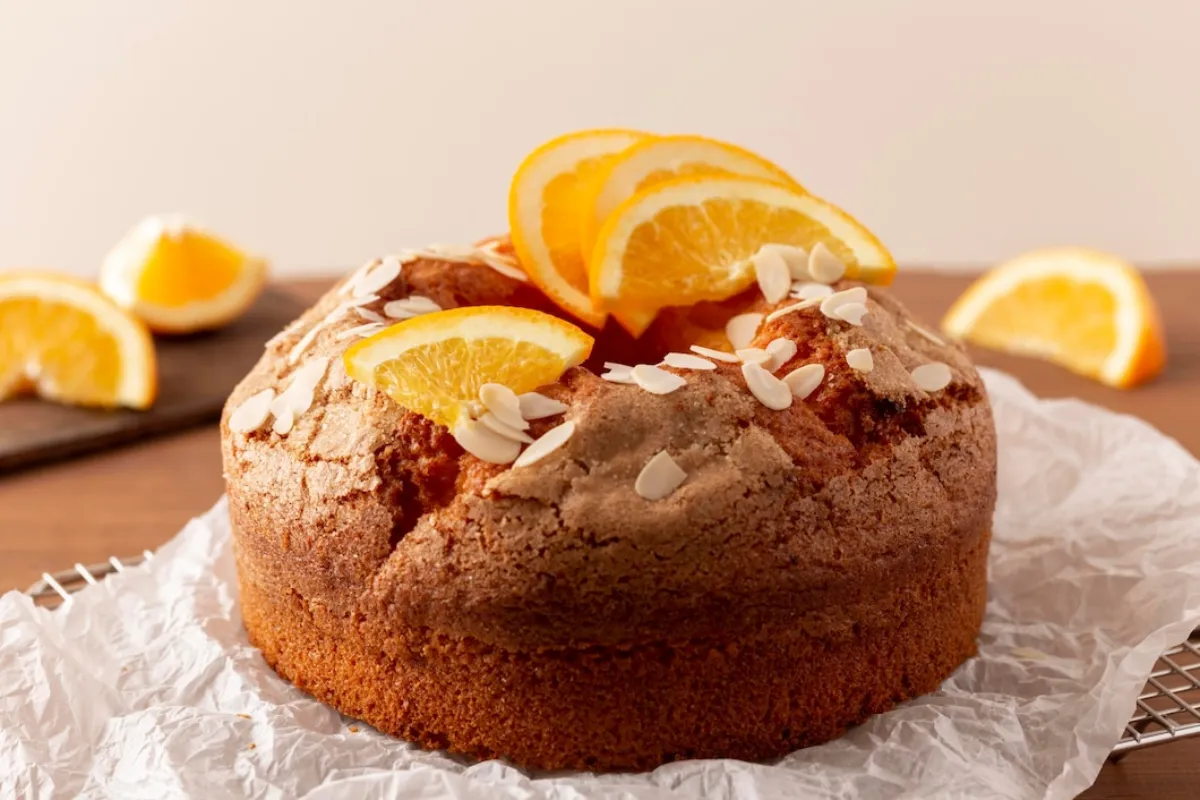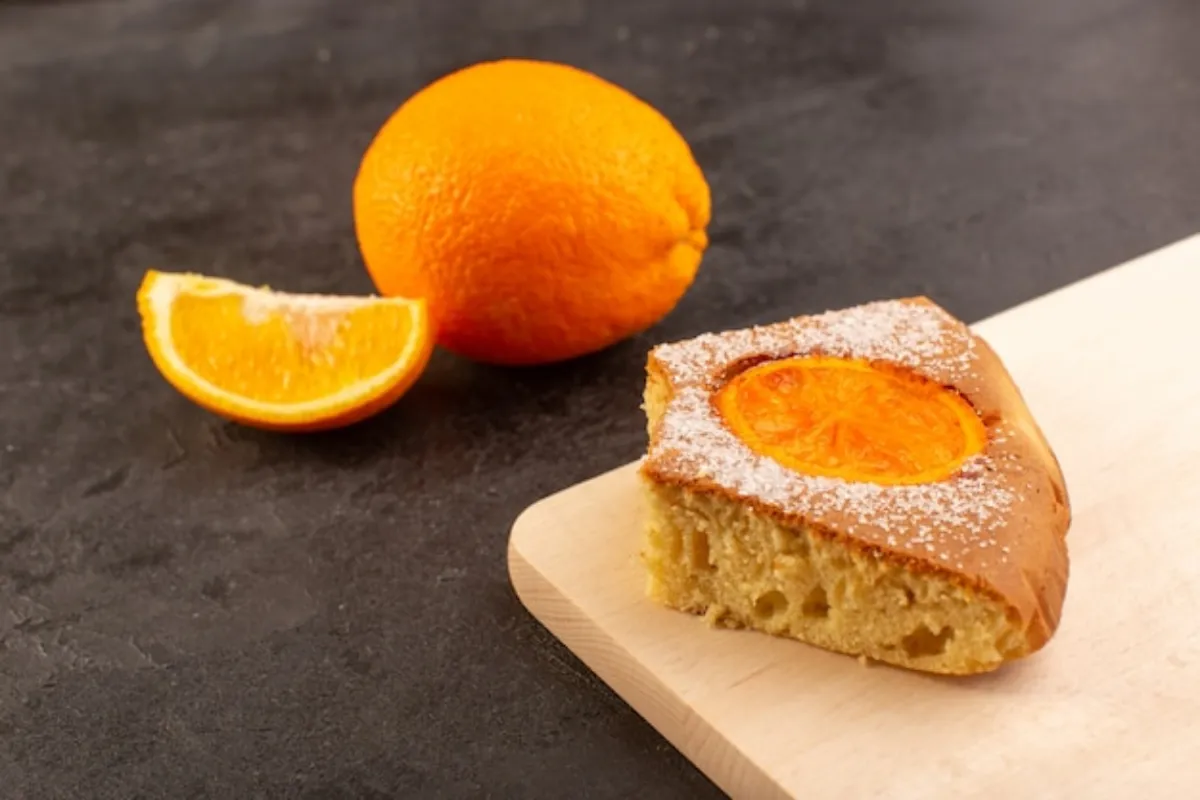Orange cake is a delightful dessert that brings together the refreshing zest of oranges with the comforting sweetness of a classic cake. Whether you’re an experienced baker or a novice in the kitchen, this guide will walk you through everything you need to know about baking the perfect orange cake. From its rich history and nutritional benefits to step-by-step recipes and creative variations, we’ve got you covered.
What is orange cake?
Orange cake is a type of cake that incorporates orange juice, zest, or both to create a vibrant, citrus-flavored dessert. This cake, from various countries, is a household staple due to its versatility and flavor spike. Whether served plain, with a glaze, or topped with frosting, orange cake is a crowd-pleaser that suits any occasion.
Why opt for orange cake?
1. Unique Flavor Profile
The combination of citrusy tang and sweet cake batter creates a refreshing flavor that’s both light and indulgent. Oranges’ natural acidity cuts through the cake’s richness, making it less heavy than traditional cakes.
2. Recipes are versatile.
You can adapt orange cake recipes to fit various dietary preferences, including gluten-free and vegan options. You can also experiment with different ingredients like chocolate, nuts, or spices to create your unique twist.
3. Perfect for Any Occasion
Whether you’re baking for a birthday, a holiday, or just because, is a versatile choice. Its bright flavor and vibrant color make it a perfect addition to any celebration.
Nutritional Benefits
Oranges are known for their high vitamin C content, but did you know that can also offer some nutritional benefits? Here’s why you might want to indulge in a slice:
1. Rich in Vitamin C
Vitamin C, an essential nutrient that supports the immune system, promotes skin health, and aids in the absorption of iron, is abundant in oranges. Incorporating orange juice or zest into your cake can give it a nutritional boost.
2. High in antioxidants
Oranges contain antioxidants like flavonoids and carotenoids, which help protect your body from oxidative stress and reduce the risk of chronic diseases. When used in baking, the juice and zest of oranges retain these compounds to some extent.
3. Fiber Content
Most of the fiber in oranges comes from the pulp and peel, but fresh zest can add some to your cake. Fiber aids in digestion and helps maintain healthy cholesterol levels.
Ingredients
Creating the perfect starts with choosing the right ingredients. Here’s a breakdown of what you’ll need:
1. Essential ingredients
- Flour: All-purpose flour works well for most orange cakes, but you can also use gluten-free flour for a GF option.
- Sugar: Granulated sugar is standard, but you can experiment with alternatives like coconut sugar or honey.
- Eggs add structure and moisture to the cake.
- Butter or oil: adds richness and helps create a tender crumb.
- Orange Juice: The best flavor comes from freshly squeezed orange juice, but you can also use bottled juice in a pinch.
- Orange Zest: Adds a concentrated orange flavor and aroma.
- Baking Powder: Helps the cake rise.
- Salt balances the sweetness and enhances flavor.
2. Optional add-ins
- Nuts: Walnuts or almonds add a delightful crunch.
- Chocolate Chips: A touch of chocolate pairs beautifully with orange.
- Spices: Cinnamon or cardamom can add warmth and complexity to the flavor.
3. Choosing fresh oranges
When choosing oranges for your cake, look for ones that are heavy for their size and have a bright, firm skin. These are indicators of juiciness and freshness. Navel oranges are a popular choice for baking due to their sweetness and lack of seeds.
Step-by-step recipe for classic orange cake
Now that you’ve gathered your ingredients, it’s time to start baking! Follow this step-by-step recipe for a classic orange cake that’s sure to impress.
1. Preheat your oven.
Preheat your oven to 350°F (175°C). Grease and flour a 9-inch round cake pan, or line it with parchment paper.
2. Prepare the wet ingredients.
In a large mixing bowl, cream together 1 cup of unsalted butter (room temperature) and 1 ½ cups of granulated sugar until light and fluffy. This should take about 3-5 minutes with an electric mixer.
Add 4 large eggs, one at a time, beating well after each addition. This guarantees the complete incorporation of the eggs and contributes to the creation of a smooth batter.
Stir in 1 tablespoon of freshly grated orange zest and ½ cup of newly squeezed orange juice.
3. Combine the dry ingredients.
In a separate bowl, whisk together 2 ½ cups of all-purpose flour, 2 teaspoons of baking powder, and ½ teaspoon of salt. Gradually add the dry ingredients to the wet mixture, mixing just until combined. Avoid overmixing, as this can lead to a dense cake.
4. Bake the cake.
Pour the batter into the prepared cake pan and smooth the top with a spatula. Bake for 30-35 minutes, or until a toothpick inserted into the center comes out clean. If the top starts to brown too quickly, cover it with aluminum foil.
5. Cool and Decorate
Allow the cake to cool in the pan for 10 minutes, then transfer it to a wire rack to cool completely. Once cooled, you can decorate the cake with your choice of frosting, glaze, or simply dust it with powdered sugar.
Variations of Orange Cake
While the classic orange cake is delicious on its own, there are many ways to get creative with this versatile dessert. Here are a few variations to try:
1. Orange Upside Down Cake
This variation features slices of fresh orange caramelized with sugar at the bottom of the cake pan. Upon inverting the cake after baking, the caramelized oranges transform into a stunning, glossy topping.
2. Vegan Orange Cake
To make a vegan orange cake, substitute the eggs with flax eggs (1 tablespoon ground flaxseed mixed with 3 tablespoons water per egg) and use plant-based butter or oil. Make sure your sugar is suitable for vegans, as some sugars undergo bone char processing.
3. Gluten-Free Orange Cake
For a gluten-free option, use a gluten-free all-purpose flour blend. Be sure to check that your baking powder is gluten-free as well. The rest of the recipe remains the same, offering a delicious cake that’s perfect for those with gluten sensitivities.

Decorating Your Orange Cake
After baking and cooling your cake, it’s time to decorate it creatively. Here are some ideas to elevate your orange cake:
1. Icing and Frosting Options
- Orange Glaze: To add a glossy finish and extra citrus flavor, make a simple glaze with powdered sugar and orange juice.
- Cream Cheese Frosting: The cream cheese frosting pairs perfectly with the tangy orange flavor, adding richness and a hint of tartness.
- Chocolate Ganache: For a decadent twist, drizzle your cake with chocolate ganache. The combination of chocolate and orange is a classic flavor pairing.
2. Decorating Ideas
- Candied Orange Slices: These not only look beautiful but also add an extra burst of orange flavor. To make them, simmer thinly sliced oranges in sugar syrup until translucent, then let them cool on a wire rack.
- Edible Flowers: Add a touch of elegance with edible flowers like pansies or marigolds.
- Zest and Sugar: A sprinkle of orange zest mixed with sugar can give your cake a sparkling finish.
3. Professional-Looking Decoration Tips
- Use a Turntable: When frosting your cake, a turntable can help you achieve a smooth, even coating when frosting your cake.
- Chill Your Cake: If you’re applying frosting, chill your cake in the refrigerator for 15-20 minutes after the crumb coat. This will help the final layer of frosting go on smoothly.
- Piping Bags: Use piping bags for precise decoration. You can create rosettes, borders, or other designs with different piping tips.
FAQs About Orange Cake
1. Can I use bottled orange juice instead of fresh oranges?
In a pinch, you can use bottled orange juice, but fresh orange juice is preferable due to its vibrant flavor and natural sweetness. Bottled juice frequently contains preservatives and added sugars, which can alter the taste of your cake.
2. How can I make my orange cake more moist?
To make your orange cake more moist, consider adding a little extra fat, such as an extra tablespoon of oil or butter. Another tip is to brush the baked cake with a simple syrup made of equal parts sugar and orange juice while it’s still warm.
3. What is the best type of flour to use for orange cake?
All-purpose flour is the most commonly used flour for orange cake, offering a satisfactory balance of texture and structure. For a lighter cake, you can sift the flour before using it. If you’re making a gluten-free cake, be sure to use a gluten-free flour blend that contains xanthan gum for binding.
4. Can I freeze an orange cake?
You can freeze orange cake for up to three months. Wrap the cooled cake tightly in plastic wrap and then in aluminum foil before placing it in the freezer. Thaw the cake in the refrigerator overnight before serving.
5. What can I substitute for eggs in an orange cake recipe?
If you need to substitute eggs, you can use flax eggs (1 tablespoon ground flaxseed mixed with 3 tablespoons water per egg), unsweetened applesauce (¼ cup per egg), or mashed bananas (¼ cup per egg). Each substitute will slightly alter the texture and flavor of the cake.
Pairing Orange Cake with Other Foods and Beverages
Pairing your orange cake with the right foods and beverages can enhance its flavor and make your dessert experience even more enjoyable. Here are some pairing suggestions:
1. Coffee and Tea
The bright citrus notes of orange cake pair beautifully with the bold flavors of coffee or the subtle nuances of tea. For a classic pairing, serve your cake with a cup of Earl Grey tea, which has a hint of bergamot, a citrus fruit.
2. Wine pairings
A light, sparkling wine, such as Prosecco or Champagne, complements the citrusy flavors of orange cake. If you prefer a still wine, opt for a Riesling or a Moscato, which have sweet, fruity notes.
3. Serving suggestions
- Whipped Cream: A dollop of freshly whipped cream adds lightness and creaminess to your slice of cake.
- Vanilla Ice Cream: Serve your orange cake with a scoop of vanilla ice cream for a delightful contrast between the warm cake and cold ice cream.
- Fruit Compote: A berry or stone fruit compote adds a burst of flavor and color to your plate.
Storing and Preserving Orange Cake
Proper storage is key to maintaining the freshness and flavor of your orange cake. Here are some tips:
1. Best Practices for Storage
Store your orange cake in an airtight container at room temperature for up to 3 days. If your kitchen is particularly warm, it’s best to refrigerate the cake to prevent spoilage. If you’ve added frosting or a glaze, be sure to store the cake in the refrigerator.
2. Keeping the orange cake fresh
To keep your cake fresh longer, you can brush it with a simple syrup (equal parts sugar and orange juice) before storing. This adds moisture and helps prevent the cake from drying out.
3. Reheating Tips
Before serving, allow your refrigerated cake to come to room temperature to fully appreciate its flavor and texture. You can also warm individual slices in the microwave for 10-15 seconds to recreate the just-baked warmth.
Conclusion
Orange cake is a versatile and delightful dessert that brings a burst of citrusy flavor to any occasion. Whether you stick to the classic recipe or experiment with variations, this cake is sure to impress your family and friends. Remember to have fun with your decorations, pair your cake with complementary foods and beverages, and enjoy the process of baking this delicious treat.
If you follow this guide, you’ll be well on your way to mastering the art of baking the perfect orange cake. So why wait? Gather your ingredients, preheat your oven, and get ready to enjoy a slice of homemade orange cake today!

